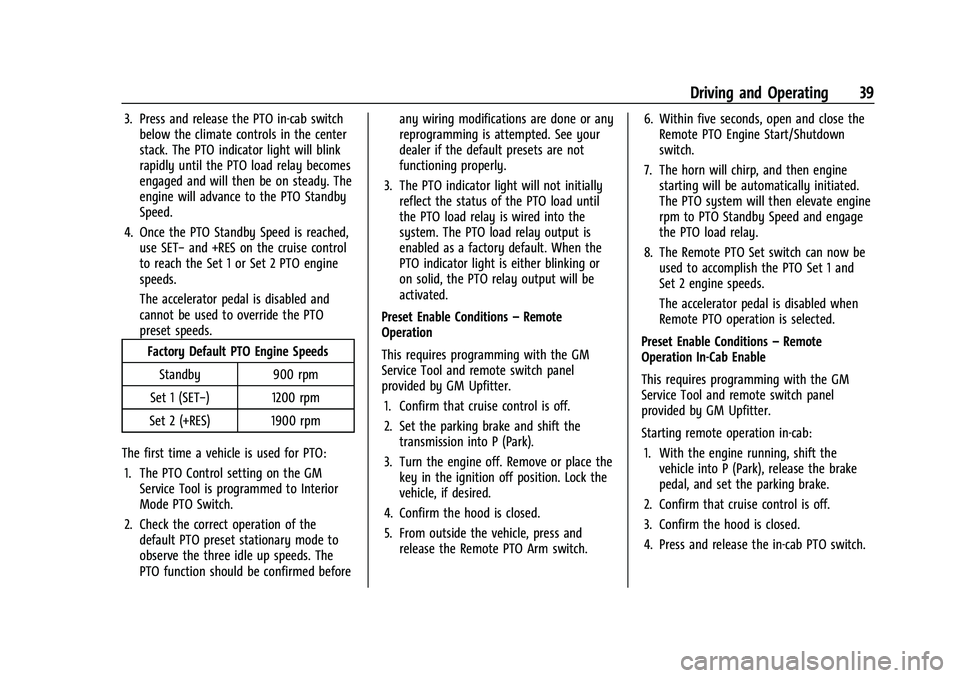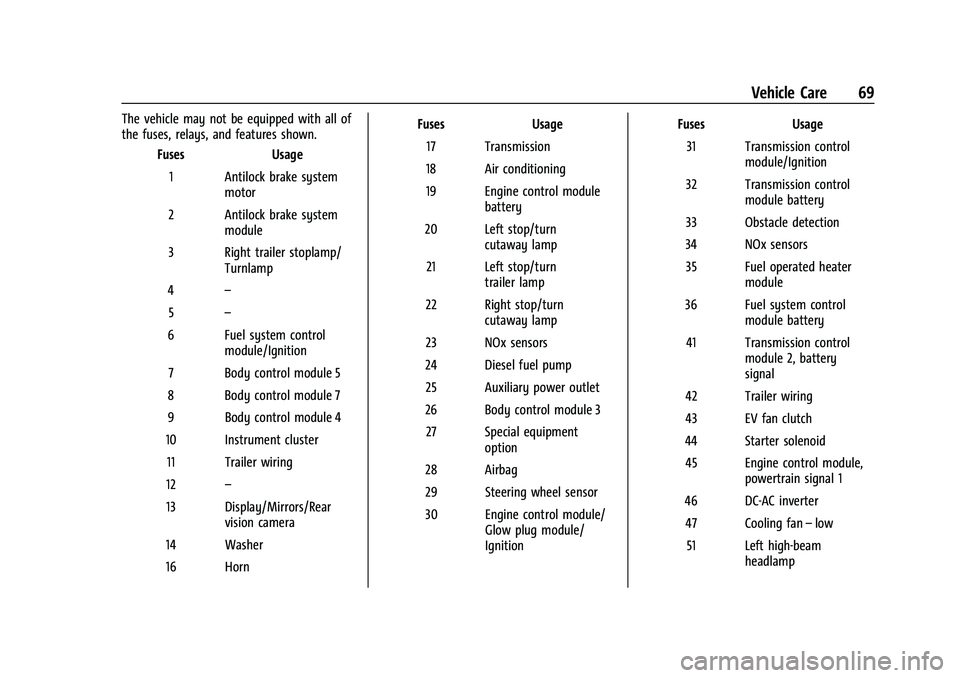2021 CHEVROLET COLORADO wiring
[x] Cancel search: wiringPage 38 of 89

Chevrolet/GMC 2.8L Duramax Diesel Engine Supplement (GMNA-Localizing-
U.S./Canada-14465442) - 2021 - CRC - 2/3/20
Driving and Operating 37
See“Trailer Towing” in the owner’s manual
for kingpin weight and trailer tongue weight
information.
Weight of the Trailer Tongue
The tongue weight load (1) of any trailer is
very important because it is also part of the
vehicle weight. The Gross Vehicle
Weight (GVW) includes the curb weight of
the vehicle, any cargo carried in it, and the
people who will be riding in the vehicle as
well as trailer tongue weight. Vehicle
options, equipment, passengers, and cargo
in the vehicle reduce the amount of tongue
weight the vehicle can carry, which will also
reduce the trailer weight the vehicle
can tow.
The trailer tongue weight (1) should be
10-15% of the total loaded trailer (2). For
Vans: The trailer tongue weight (1) can use a
weight carrying hitch for up to 181 kg
(400 lb). Greater than 181 kg (400 lb), a
weight distribution hitch is required with a
maximum of 454 kg (1,000 lb)
Do not exceed the maximum allowable
tongue weight for the vehicle. Choose the
shortest hitch extension that will position
the hitch ball closest to the vehicle. This will
help reduce the effect of trailer tongue
weight on the rear axle.
Trailer rating may be limited by the vehicle's
ability to carry tongue weight. Tongue or
kingpin weight cannot cause the vehicle to
exceed the GVWR (Gross Vehicle Weight
Rating) or the RGAWR (Rear Gross Axle
Weight Rating). See “Total Weight on the
Vehicle's Tires” in the owner’s manual.
After loading the trailer, weigh the trailer
and then the tongue, separately, to see if
the weights are proper. If they are not,
adjustments might be made by moving
some items around in the trailer.
If a cargo carrier is used in the trailer hitch
receiver, choose a carrier that positions the
load as close to the vehicle as possible.
Make sure the total weight, including the carrier, is no more than half of the
maximum allowable tongue weight for the
vehicle or 227 kg (500 lb), whichever is less.
Conversions and Add-Ons
Power Take-Off (PTO)
If equipped, the Power Take-Off (PTO) is a
GM Upfitter integrated system that is used
to create an auxiliary power source for
running add-on equipment, such as salt
spreaders, snow plows, winches, and lift
buckets. The PTO system controls engine
speed to values higher than normal base
idle, PTO load relay engagement, and
remote starting and shutdown of the
engine.
When installing PTO aftermarket equipment,
the PTO wiring and operation
recommendations provided by the service
manual and GM Upfitter documentation
must be strictly followed.
Refer to the bulletins in the GM Upfitter
Integration website www.gmupfitter.com for
the Power Take-Off (PTO) operating
description and application guide.
Page 40 of 89

Chevrolet/GMC 2.8L Duramax Diesel Engine Supplement (GMNA-Localizing-
U.S./Canada-14465442) - 2021 - CRC - 2/3/20
Driving and Operating 39
3. Press and release the PTO in-cab switchbelow the climate controls in the center
stack. The PTO indicator light will blink
rapidly until the PTO load relay becomes
engaged and will then be on steady. The
engine will advance to the PTO Standby
Speed.
4. Once the PTO Standby Speed is reached, use SET− and +RES on the cruise control
to reach the Set 1 or Set 2 PTO engine
speeds.
The accelerator pedal is disabled and
cannot be used to override the PTO
preset speeds.
Factory Default PTO Engine Speeds
Standby 900 rpm
Set 1 (SET−) 1200 rpm
Set 2 (+RES) 1900 rpm
The first time a vehicle is used for PTO: 1. The PTO Control setting on the GM Service Tool is programmed to Interior
Mode PTO Switch.
2. Check the correct operation of the default PTO preset stationary mode to
observe the three idle up speeds. The
PTO function should be confirmed before any wiring modifications are done or any
reprogramming is attempted. See your
dealer if the default presets are not
functioning properly.
3. The PTO indicator light will not initially reflect the status of the PTO load until
the PTO load relay is wired into the
system. The PTO load relay output is
enabled as a factory default. When the
PTO indicator light is either blinking or
on solid, the PTO relay output will be
activated.
Preset Enable Conditions –Remote
Operation
This requires programming with the GM
Service Tool and remote switch panel
provided by GM Upfitter.
1. Confirm that cruise control is off.
2. Set the parking brake and shift the transmission into P (Park).
3. Turn the engine off. Remove or place the key in the ignition off position. Lock the
vehicle, if desired.
4. Confirm the hood is closed.
5. From outside the vehicle, press and release the Remote PTO Arm switch. 6. Within five seconds, open and close the
Remote PTO Engine Start/Shutdown
switch.
7. The horn will chirp, and then engine starting will be automatically initiated.
The PTO system will then elevate engine
rpm to PTO Standby Speed and engage
the PTO load relay.
8. The Remote PTO Set switch can now be used to accomplish the PTO Set 1 and
Set 2 engine speeds.
The accelerator pedal is disabled when
Remote PTO operation is selected.
Preset Enable Conditions –Remote
Operation In-Cab Enable
This requires programming with the GM
Service Tool and remote switch panel
provided by GM Upfitter.
Starting remote operation in-cab:
1. With the engine running, shift the vehicle into P (Park), release the brake
pedal, and set the parking brake.
2. Confirm that cruise control is off.
3. Confirm the hood is closed.
4. Press and release the in-cab PTO switch.
Page 52 of 89

Chevrolet/GMC 2.8L Duramax Diesel Engine Supplement (GMNA-Localizing-
U.S./Canada-14465442) - 2021 - CRC - 2/3/20
Driving and Operating 51
.PTO: REDUCE VEHICLE SPEED
.PTO: REDUCE ENGINE SPEED
.PTO: DISENGAGE CRUISE CONTROL
.PTO: ACCELERATION UPON BRAKE RELEASE
.PTO: SERVICE PTO
.PTO: SHIFT TO M1, M2 OR M3 (Mobile
mode only)
.Action Required Cleaning Exhaust Filter
Continue Driving (DPF only)
.Action Required Cleaning Exhaust Filter
Must Continue Driving (DPF only)
.Exhaust Filter Cleaning Available Go to
Options Menu (DPF only)
In addition, the PTO indicator light will light
when all conditions required to engage PTO
have not been met. When enabling PTO, the
PTO indicator light will turn on, then turn
off after one second. Under normal
operating conditions, the PTO indicator light
will remain on throughout the PTO
operating cycle.
Additional in-vehicle PTO module
information can be accessed by the service
technician to aid in troubleshooting. Also see
the service manual for more information. The GM service technician can access Service
Tool information that will contain reasons
why PTO may not engage and why PTO
may unexpectedly disengage due to system
conditions.
See www.gmupfitter.com for information on
the installation of wiring and programming
for PTO aftermarket equipment.
Diesel Particulate Filter Cleaning during
PTO Operation
This feature is only available on Fleet and
Commercial vehicles. To verify that the
vehicle has this feature, see
www.gmupfitter.com to contact the GM
Upfitter Integration Group for assistance.
If equipped, this feature allows for manual
cleaning/regeneration of the Diesel
Particulate Filter (DPF) when it is unable to
clean itself. It may be necessary to perform
a manual regeneration if driving conditions
—
such as extended slow speed, stop-and-go
traffic, extended idles, short drive cycles,
or stationary PTO operation —prevent DPF
self-cleaning. Manual regeneration can only be used when
the DPF has become at least 90% full. At
100% full, it will attempt to automatically
self-clean if proper driving conditions are
met. The DPF will clean itself if the vehicle
can be driven above 50 km/h (30 mph) for
about 30 minutes.
Manual regeneration can be used during a
stationary PTO session. However it is
strongly recommended that the exhaust
filter be cleaned before continuous PTO.
If manual regeneration is operating
concurrently with PTO then the PTO system
will retain control of the engine speed. Low
PTO engine speeds will cause regeneration
to take longer. To initiate a manual DPF
regeneration, see
“Manual Regeneration of
Diesel Particulate Filter” inDiesel Particulate
Filter 019.
Page 70 of 89

Chevrolet/GMC 2.8L Duramax Diesel Engine Supplement (GMNA-Localizing-
U.S./Canada-14465442) - 2021 - CRC - 2/3/20
Vehicle Care 69
The vehicle may not be equipped with all of
the fuses, relays, and features shown.Fuses Usage
1 Antilock brake system motor
2 Antilock brake system module
3 Right trailer stoplamp/ Turnlamp
4 –
5 –
6 Fuel system control module/Ignition
7 Body control module 5
8 Body control module 7
9 Body control module 4
10 Instrument cluster 11 Trailer wiring
12 –
13 Display/Mirrors/Rear vision camera
14 Washer
16 Horn Fuses Usage
17 Transmission
18 Air conditioning
19 Engine control module battery
20 Left stop/turn cutaway lamp
21 Left stop/turn trailer lamp
22 Right stop/turn cutaway lamp
23 NOx sensors
24 Diesel fuel pump 25 Auxiliary power outlet
26 Body control module 3 27 Special equipment option
28 Airbag
29 Steering wheel sensor
30 Engine control module/ Glow plug module/
Ignition Fuses Usage
31 Transmission control module/Ignition
32 Transmission control module battery
33 Obstacle detection
34 NOx sensors 35 Fuel operated heater module
36 Fuel system control module battery
41 Transmission control module 2, battery
signal
42 Trailer wiring
43 EV fan clutch
44 Starter solenoid 45 Engine control module, powertrain signal 1
46 DC-AC inverter 47 Cooling fan –low
51 Left high-beam headlamp